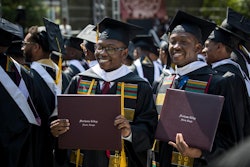Under new education department programs, money for eligible colleges and universities is up for grabs.
Colleges that do not qualify as historically Black colleges or tribal colleges but that still serve a significant number of African-Americans or American Indians have until late June to make their case for a share of $20 million in new federal funds for such institutions.
Funds are available under two new U.S. Department of Education programs approved by Congress: $15 million in grants for predominantly Black institutions (PBIs) and $5 million for non-tribal colleges, mostly in the western United States, that serve American Indian students.
To qualify as a non-tribal, Native American- serving institution, a college need only have an undergraduate enrollment that is 10 percent American Indian, the regulations state. The criteria for a predominantly Black institution are more detailed, although a core requirement is that the college or university have “at least 40 percent Black American students,” the Department of Education says.
“It’s not quite what we had envisioned,” says Dr. Edison Jackson, president of Medgar Evers College in Brooklyn, N.Y. Jackson tells Diverse that he had hoped that a college would need an enrollment that is 50 percent Black to qualify for the new program.
The lower cutoff likely will increase the number of eligible colleges and universities, he says. Nonetheless, “We are grateful that the program passed. This is a major plus.”
Institutions such as Medgar Evers and Chicago State University have worked for years to gain a foothold in the federal budget alongside the larger programs for historically Black colleges, arguing that the mostly urban PBIs serve many low-income African-Americans who are the first generation in their families to attend college.
In the PBI competition, grant proposals can focus on science, technology, engineering and math (STEM) fields, as well as health education, teacher preparation and international issues. Another priority is to improve the educational outcome of Black males.
An individual college can receive up to $600,000, and the Department of Education expects to award about 25 grants. In addition to the 40 percent Black enrollment requirement, a college must offer an associate or bachelor’s degree and have at least 1,000 undergraduate students, the Bush administration says. Half of all students should be Pell Grant recipients or graduates of schools with poverty rates above 30 percent or school districts receiving significant Title I funding.
Sen. Barack Obama, D-Ill., who is the presumptive Democratic presidential candidate this year, authored a Senate bill to fund predominantly Black institutions. Rep. Danny Davis, D-Ill., had proposed similar legislation in the House.
The aid to predominantly Black colleges, provided through a program that is separate from those aiding HBCUs, has the support of historically Black colleges, says Edith Bartley, government relations director at UNCF.
In announcing the competition in mid May, the department set an application deadline of June 27. The Department of Education will evaluate applications on criteria that include need for the project; quality of project services, personnel and design; evaluation plan; and management plan.
Only four colleges and universities will receive funds under the new competition for non-tribal, Native American-serving colleges and universities. However, individual grant amounts are much higher than those going to predominantly Black institution’s competitions.
The grants to non-tribal, Native American- serving colleges can reach as high as $1.25 million. Applications are due June 26.
Sen. Jeff Bingaman, D-N.M., a chief sponsor of the new program, has said that the initiative will support curriculum development, instruction and faculty development at these recipient institutions.
Bingaman said his home state has many institutions that will qualify for the program, including San Juan College, University of New Mexico-Gallup, New Mexico State University-Grants and Eastern New Mexico University-Ruidoso.
Those that win these new funds are eligible for two-year grants.
A $5 million grant competition for Asian American and native Pacific Islander-serving colleges and universities is also open. The education department has $5 million available for this program, which also has a June 26 deadline. To qualify for this program, a college or university must have 10 percent enrollment of either Asian American students or native Pacific Islander students.
Click here to post and read comments
© Copyright 2005 by DiverseEducation.com


















